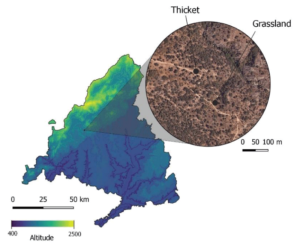Assessing Bee (Hymenoptera, Apoidea, Anthophila) Diversity and Floral Preference in Two Habitats in the Iberian Peninsula
Exploring Bee Diversity and Floral Preference in the Iberian Peninsula: A Study of Ecosystem Resilience, Biodiversity, and Microbiology
Bees play a crucial role in maintaining ecological balance and fostering biodiversity by acting as efficient pollinators. A recent study titled “Assessing Bee Diversity and Floral Preference in Two Habitats in the Iberian Peninsula” provides significant insights into the complex dynamics of bee populations, their floral preferences, and their impact on ecosystem resilience. This research, conducted over two years in the Sierra de Guadarrama region, highlights the intricate relationship between bees, flowers, and their habitats, emphasizing the importance of preserving biodiversity in the face of climate change.
The Importance of Bees in Ecosystems
Bees are essential for pollination, a process that sustains both wild plant reproduction and agricultural productivity. Over 90% of angiosperm species rely on animal pollinators, with bees being the most efficient. The global economic value of bee-mediated pollination is estimated at $235–$577 billion annually, underscoring their role in food security and ecosystem resilience.
Study Overview: Objectives and Methods
This study focused on two habitats within the Sierra de Guadarrama: a grassland and a thicket. Researchers aimed to:
- Create an inventory of bee and plant communities.
- Compare biodiversity across the two habitats.
- Investigate the circadian rhythms and seasonal activity of bee populations.
Bee sampling was conducted using net trapping techniques across two years (2017–2019). Over 331 individual bees from six families and 46 species were recorded. Data were analyzed using statistical methods to identify patterns in biodiversity, plant preference, and activity.
 Figure: Location of the study sites, the thicket and the grassland, Galapagar, Madrid, Spain.
Figure: Location of the study sites, the thicket and the grassland, Galapagar, Madrid, Spain.
Key Findings: Ecosystem Resilience and Biodiversity
- Bee Diversity Across Habitats
- Grasslands hosted more bee individuals (270) than thickets (61).
- Apidae was the most abundant family (82%), followed by Megachilidae (8%) and others.
- Plant Preference
- Bees showed a marked preference for specific flowers. In the thicket, Cistus ladanifer dominated, while in the grassland, Lavandula angustifolia was most visited.
- Phenological Patterns
- Bee activity peaked during late spring and early summer (May–July), coinciding with higher temperatures and flower abundance.
- Circadian activity varied, with the majority of bees active midday and in the afternoon.
Floral Interactions and Microbiology
The study revealed that bee species with different tongue lengths preferred specific floral structures:
- Short-tongued bees: Favored flowers with open corollas like Cistus ladanifer.
- Long-tongued bees: Preferred flowers with tubular corollas like Lavandula angustifolia.
This interaction highlights the role of microbiology in shaping plant-pollinator dynamics, as floral structures influence nectar accessibility and microbial communities, further impacting pollinator behavior.
Threats to Bee Populations
Bees face numerous threats, including:
- Climate Change: Altered phenological patterns disrupt the synchronization between flowering plants and pollinators.
- Habitat Loss: Agricultural intensification and urbanization reduce floral diversity.
- Competition from Managed Bees: The dominance of honeybees (Apis mellifera) often displaces wild bees, limiting their access to floral resources.
Implications for Conservation
This study underscores the importance of preserving diverse habitats to maintain healthy pollinator communities. Key recommendations include:
- Promoting native plant species that support a variety of pollinators.
- Protecting natural habitats to ensure floral resource availability throughout the year.
- Encouraging sustainable beekeeping practices to mitigate competition between managed and wild bees.
Future Directions in Research and Conservation
- Integrating Biostatistics and Microbiology
Advanced statistical tools and microbiological studies can further elucidate the complex relationships between bees, flowers, and their habitats, aiding in ecosystem modeling. - Expanding Geographic Scope
Similar studies across diverse ecosystems can provide comparative insights into bee biodiversity and ecosystem resilience. - Adapting to Climate Change
Monitoring and mitigating the impacts of climate change on pollination networks is essential for future ecosystem management.
Conclusion
The findings from this study reinforce the critical role of bees in fostering biodiversity and ecosystem resilience. By understanding their floral preferences and activity patterns, we can develop targeted conservation strategies to protect these invaluable pollinators. This research serves as a reminder of the interconnectedness of biodiversity, microbiology, and ecological health, emphasizing the need for concerted efforts to preserve our natural world.
References
- Bharati M, Singh V, Kripal R. Modeling of Cr³⁺ doped Cassiterite (SnO₂) Single Crystals. HTML | PDF.
- DOI: 10.61927/igmin208.
FAQs
What was the main focus of the study on bee diversity in the Iberian Peninsula?
The study examined bee diversity, floral preferences, and activity patterns in two habitats (grassland and thicket) within the Sierra de Guadarrama region to understand the relationship between bees, flowers, and their ecological environment.What were the key findings about bee preferences for flowers?
Bees showed distinct preferences based on floral structure. Short-tongued bees favored open corolla flowers like Cistus ladanifer, while long-tongued bees preferred tubular flowers like Lavandula angustifolia.How does climate change affect bees and their ecosystems?
Climate change disrupts the synchronization between flowering periods and bee activity, leading to reduced pollination efficiency and potential declines in bee populations due to resource mismatches.What role do honeybees (Apis mellifera) play in wild bee populations?
Honeybees can dominate floral resources, potentially displacing wild bees and limiting their access to essential flowers, thereby impacting wild bee biodiversity.What conservation strategies are recommended based on this study?
Recommendations include preserving native flowering plants, protecting natural habitats, promoting sustainable beekeeping, and monitoring the effects of climate change on plant-pollinator networks to ensure ecosystem resilience.
